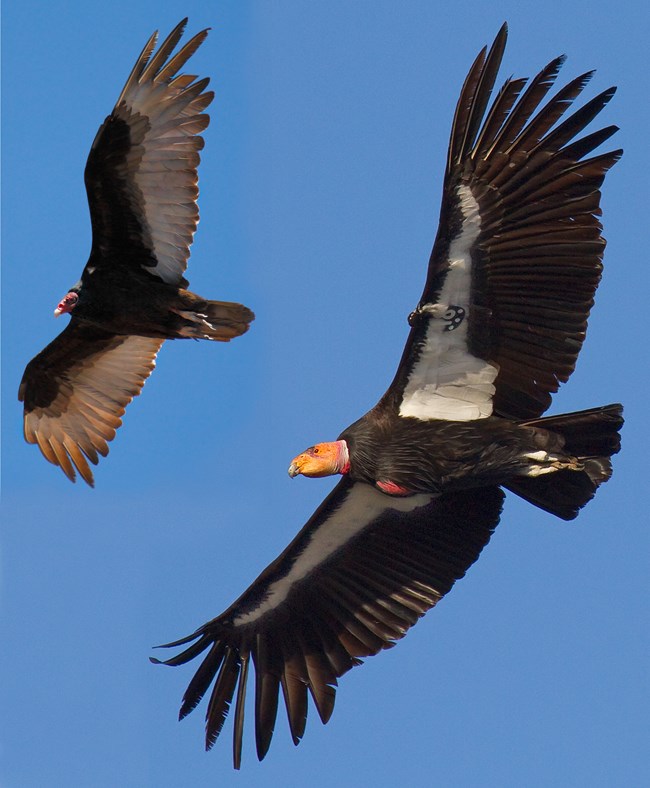California Condor Size Comparison: How They Measure Up
The california condor is one of the largest bird species in north america, with a wingspan of up to 9.8 feet and weighing between 18-31 pounds. The size of an adult california condor can be compared to that of a turkey vulture, with the former being slightly larger.
These birds were once on the brink of extinction, but through conservation efforts, their numbers have increased. Today, california condors can be found in arizona, california, and parts of southern utah and northern mexico. The california condor’s impressive size has long been a topic of curiosity among people.
In this article, we will explore the measurements and size of these birds compared to other species. We will also discuss the factors that have contributed to their decline in numbers and the measures taken to restore their population. Join us on this exciting journey of discovering the world of the magnificent california condor.
Credit: www.nps.gov
Physical Characteristics Of The California Condor
California Condor Size Comparison: How They Measure Up
The physical characteristics of the california condor set it apart as one of the most impressive birds in north america. These birds are known for their massive size and striking appearance, making them an unmissable sight in the wild. We will explore the key features that define the california condor: their wingspan, body length, weight, and gender differences in size.
Wingspan
The wingspan of the california condor is one of its most remarkable features. These birds have the largest wingspan of any bird in north america, reaching up to 9. 5 feet. This impressive wingspan allows them to soar high in the sky, covering long distances with ease.
Body Length
Along with their wingspan, california condors are also known for their impressive body length. These birds can grow up to 4. 5 feet long from beak to tail. Their long, slender bodies are covered in black feathers with distinctive white patches under their wings, making them easy to spot in the wild.
Weight
The weight of the california condor is another aspect that sets them apart. These birds are one of the heaviest flying birds in the world, with males weighing up to 26 pounds and females weighing up to 22 pounds. Despite their weight, they are able to fly easily thanks to their powerful wings and broad, soaring flight.
Gender Differences In Size
There are noticeable differences in size between male and female california condors. Males are typically larger than females, with longer wings, longer bodies, and heavier overall weight. Female condors have shorter wingspans and smaller bodies, making them slightly more compact than their male counterparts.
The physical characteristics of the california condor are truly impressive. These birds are known for their massive wingspans, long bodies, and impressive weights. By understanding these key features, we can gain a better appreciation for the beauty and strength of these remarkable birds.
California Condor Size Comparison To Other Vultures
California Condor Size Comparison: How They Measure Up
The california condor is awe-inspiring, not only for its enormous size but also because it is one of the world’s rarest birds. This bird’s unique physical features are fascinating to bird enthusiasts and nature lovers alike. In this blog post, we’ll delve into the california condor’s size and compare it to other vultures.
Comparison To The Turkey Vulture
The turkey vulture is a common sight across north and south america, and it is often confused with the california condor, although it’s much smaller. Here are the key differences:
- The california condor has a wingspan of 9.5 feet, while the turkey vulture’s wingspan is only 6 feet.
- The california condor weighs between 18 and 31 pounds, while the turkey vulture only weighs between 2 and 4 pounds.
- The california condor has a striking black coloration, while the turkey vulture’s feathers are a mix of black and brown.
Comparison To The Andean Condor
The andean condor, also known as the south american condor or andean vulture, is the only other species of condor. Here’s how it compares to the california condor:
- The andean condor has a wingspan of up to 10.5 feet, slightly longer than the california condor.
- The andean condor is also heavier than the california condor, weighing between 20 and 33 pounds.
- The andean condor has distinct white feathers on its neck, while the california condor does not.
Comparison To The Bearded Vulture
Lastly, let’s look at how the california condor compares to the bearded vulture, also known as the lammergeier:
- The bearded vulture has a wingspan of 7 to 9 feet, smaller than both the california and andean condors.
- The bearded vulture weighs between 4 and 7 pounds, making it much lighter than the california condor.
- The bearded vulture has reddish-brown feathers on its head and neck, while the california condor does not have this feature.
Although the california condor is one of the largest birds in the world, it is clear that it is not the only species that boasts an impressive size. By comparing the california condor to other vultures, such as the turkey vulture, andean condor, and bearded vulture, it’s easy to see how each bird is unique and fascinating in its way.
Whether you’re a bird enthusiast or not, these giant birds are an awe-inspiring sight to behold, and they remind us of the incredible diversity of wildlife on our planet.
Adaptations For Flight
California Condor Size Comparison: How They Measure Up
The california condor is a majestic bird with a wingspan that can reach up to 10 feet. These incredible birds have evolved to have unique adaptations that enable them to take flight with ease. In this section, we’ll dive into the adaptations that give california condors the power to soar through the skies.
Wing Structure
The california condor has a unique wing structure that allows it to fly long distances without expending too much energy. Here are some key points to note about the species’ wings:
- The wings are long, with a span that can reach up to 10 feet, making them the largest wingspan of any bird in north america
- They have a v-shape, which helps with lift and stability in the air
- The primary feathers at the tip of the wings can move independently and help control the bird’s direction in flight
Aerodynamics
Aerodynamics are essential for any bird who wants to fly, and the california condor has evolved to have a unique aerodynamic makeup. Here are the key points to know:
- Their streamlined bodies help reduce drag and increase efficiency
- The way air flows over the wing’s surface affects lift, and california condors have adapted to maximize this effect
- The feathers on their wings have barbs that latch onto one another, creating a smooth surface that helps air flow over the wings more efficiently
Lift And Soaring Techniques
California condors are masters of the skies and have developed sophisticated techniques for lift and soaring. Here are some key points:
- These birds use thermals, which are rising columns of warm air, to gain altitude without exerting energy
- They can soar for hours without flapping their wings, using updrafts to stay aloft
- Gliding from high elevations allows the california condor to conserve energy and stay in flight for longer periods
How Size Impacts Flight Ability
The california condor’s size has a significant impact on its ability to fly. Here are some key points:
- Their size makes them more vulnerable to strong winds, which can knock them off course
- Their wingspan makes them more difficult to maneuver in tight spaces, such as when landing on a perch
- However, their size also provides them with unique abilities, such as the ability to glide long distances without flapping their wings
Although the california condor may face some limitations due to its size, its unique adaptations make it one of the world’s most impressive birds of prey. From its wing structure to its soaring techniques, these birds have evolved to be masters of the skies.
Conservation Efforts For California Condors
The california condor is a majestic bird with a wingspan of up to 9. 8 feet, making it one of the largest birds in north america. However, the california condor has experienced a population decline, dangerously close to extinction. Conservation efforts have become crucial in preventing the california condor’s extinction.
Population Decline And Endangerment
The population of the california condor has been on the decline for decades, and now with less than 500 birds remaining in the wild. Reasons for their population decline are due to habitat loss, lead poisoning, and poaching. The california condor was listed as an endangered species in 1967.
- The population of the california condor has been on a steady decline since the early 20th century.
- The california condor was listed as an endangered species in 1967.
- The leading reasons behind their endangered status include habitat loss, lead poisoning, and poaching.
Restoration And Recovery
Conservation efforts for the california condor began in 1982 with the implementation of a breeding and reintroduction program. The california condor recovery program has successfully increased the population of california condors from 22 birds to over 400 today.
- Conservation efforts for the california condor began in 1982.
- The california condor recovery program has successfully increased the population of california condors from 22 birds to over 400 today.
- Today, reintroduction programs are in place throughout the us, mexico, and canada to ensure the survival of this magnificent bird.
The Role Of Size Comparisons In Conservation Efforts
Size comparison plays an essential role in conservation efforts for the california condor. Monitoring the sizes of these birds can indicate their health, breeding patterns, and distribution throughout their habitats. Data analyzed from the california condor size comparisons helps conservationists identify population trends and establish conservation priorities.
- Size comparison plays an essential role in california condor conservation efforts.
- Data analyzed from california condor size comparisons helps conservationists identify population trends and establish conservation priorities.
- The size of california condors can indicate their health, breeding patterns, and distribution throughout their habitats.
Conservation efforts are crucial to the survival of california condors. Despite their population decline, serious populations have resulted in the rescue of these majestic birds. California condor size comparisons reveal various information, including data that helps plan and prioritize conservation efforts.
Frequently Asked Questions For California Condor Size Comparison: How They Measure Up
How Big Are California Condors Compared To Other Birds?
California condors are one of the largest birds in north america with a wingspan of up to 10ft, making them comparable in size to small airplanes like cessnas.
Are California Condors Endangered?
Yes, california condors are endangered species, and efforts have been made to save them from extinction. The condor population dropped to just 27 birds in 1987, but today there are approximately 500 in the wild.
What Causes The Decline Of California Condors Population?
The decline of the california condors population was due to a variety of reasons such as habitat loss, hunting, lead poisoning, and fragmentation of their populations, resulting in a genetic bottleneck.
Can California Condors Be Seen In The Wild?
Yes, california condors can be seen in the wild, but it’s rare. They are mainly found in california, arizona, and utah, where they live in mountainous areas and nest on cliffs.
How Do California Condors Find Their Prey?
California condors locate their food by sight and smell. They typically feed on carrion, and their strong sense of smell enables them to locate decaying animals from miles away, and they can fly up to 150 miles in search of their next meal.
When Was The California Condor First Discovered?
California condor was first discovered in 1592 and named by spanish explorers, who were the first to see the bird while exploring the west coast of north america.
Conclusion
The california condor is undoubtedly one of the most unique birds in the world with its impressive size and striking appearance. Despite being one of the largest birds in north america, it is interesting to discover that this iconic species shares many common characteristics with other bird species and animals.
By understanding the size comparison of the california condor and other birds, we can appreciate the significance of this magnificent bird, not just in terms of its size but also for its cultural and ecological importance. The california condor’s conservation story is a remarkable testament to how collective efforts can help protect and preserve a species on the brink of extinction.
It is our responsibility to appreciate these birds and their role in nature and continue to support conservation initiatives for their survival.








